Impact of High Temperatures on Tourist Flows in Urban and Rural Areas: Climate Adaptation Strategies in China
Abstract
:1. Introduction
2. Literature Review
2.1. Impact of Climate Change on Tourist Flows
2.2. Impact of High Temperatures on Urban and Rural Tourist Flow
2.3. Climate Adaptation of Tourist Destinations
2.4. Shortcomings in the Existing Research and Research Framework of This Study
3. Methodology
3.1. Study Area
3.2. Data Sources
3.3. Methods
3.3.1. SOFM Method
3.3.2. JNB Method
3.3.3. Tourist Flow Modeling for Tourist Attractions
3.3.4. Pearson Correlation Analysis
4. Results
4.1. Urban and Rural Structures
4.2. Characteristics of Urban and Rural Tourist Flows Under High Temperatures
4.2.1. Temporal Characteristics
4.2.2. Spatial Characteristics
4.3. Key Factors Impacting Urban and Rural Tourist Flows Under High Temperatures
4.3.1. Selection of Impacting Factors
4.3.2. Analysis of Impacting Factors
4.4. Climate Adaptation Strategies for Urban and Rural Tourism
5. Discussion and Implications
5.1. Temporal Variations in Urban and Rural Tourist Flows Under High Temperatures
5.2. Spatial Variations in Urban and Rural Tourist Flows Under High Temperatures
5.3. Differences in Driving Factors
5.4. Practical Implications
5.5. Limitation and Future Studies
6. Conclusions
Author Contributions
Funding
Institutional Review Board Statement
Data Availability Statement
Conflicts of Interest
References
- Durán-Camejo, B.R.; Rivera-Vázquez, J.A.; Serrano-Leyva, B.; Batista-Pérez, O. Tourist leisure in scientific production in Scopus: Current trends and research agenda. Rev. San Gregor. 2024, 1, 98–108. [Google Scholar] [CrossRef]
- Bielska, A.; Borkowski, A.S.; Czarnecka, A.; Delnicki, M.; Kwiatkowska-Malina, J.; Piotrkowska, M. Evaluating the Potential of Suburban and Rural Areas for Tourism and Recreation, Including Individual Short-Term Tourism under Pandemic Conditions. Sci. Rep. 2022, 12, 20369. [Google Scholar] [CrossRef]
- Liao, Y.T.; Chern, S.G. Strategic Ecocity Development in Urban–Rural Fringes: Analyzing Wulai District. Sustain. Cities Soc. 2015, 19, 98–108. [Google Scholar] [CrossRef]
- Sun, Y.; Shao, Y.; Chan, E.H.W. Co-Visitation Network in Tourism-Driven Peri-Urban Area Based on Social Media Analytics: A Case Study in Shenzhen, China. Landsc. Urban Plan. 2020, 204, 103934. [Google Scholar] [CrossRef]
- Pan, W.; Du, J. Impacts of Urban Morphological Characteristics on Nocturnal Outdoor Lighting Environment in Cities: An Empirical Investigation in Shenzhen. Build. Environ. 2021, 192, 107587. [Google Scholar] [CrossRef]
- Ghasemi, M.; González-García, A.; Charrahy, Z.; Serrao-Neumann, S. Utilizing Supply-Demand Bundles in Nature-Based Recreation Offers Insights into Specific Strategies for Sustainable Tourism Management. Sci. Total Environ. 2024, 922, 171185. [Google Scholar] [CrossRef]
- Jamhawi, M.M.; Zidan, R.J.; Sherzad, M.F. Tourist Movement Patterns and the Effects of Spatial Configuration in a Cultural Heritage and Urban Destination: The Case of Madaba, Jordan. Sustainability 2023, 15, 1710. [Google Scholar] [CrossRef]
- Li, Y.; Gong, G.; Zhang, F.; Gao, L.; Xiao, Y.; Yang, X.; Yu, P. Network Structure Features and Influencing Factors of Tourism Flow in Rural Areas: Evidence from China. Sustainability 2022, 14, 9623. [Google Scholar] [CrossRef]
- Xu, D.; Zhang, J.-H.; Huang, Z.; Zhou, Y.; Fan, Q. Tourism Community Detection: A Space of Flows Perspective. Tour. Manag. 2022, 93, 104577. [Google Scholar] [CrossRef]
- Caldeira, A.M.; Kastenholz, E. It’s so Hot: Predicting Climate Change Effects on Urban Tourists’ Time–Space Experience. J. Sustain. Tour. 2018, 26, 1516–1542. [Google Scholar] [CrossRef]
- Gebbisa, M.B.; Yasin, A.S.; Bacsi, Z. Impacts of Weather Variability on the International Tourism Receipts—Evidence from Ethiopia (1995–2019). Tour. Hosp. 2024, 5, 416–438. [Google Scholar] [CrossRef]
- Turek-Hankins, L.L.; Coughlan De Perez, E.; Scarpa, G.; Ruiz-Diaz, R.; Schwerdtle, P.N.; Joe, E.T.; Galappaththi, E.K.; French, E.M.; Austin, S.E.; Singh, C.; et al. Climate Change Adaptation to Extreme Heat: A Global Systematic Review of Implemented Action. Oxf. Open Clim. Change 2021, 1, kgab005. [Google Scholar] [CrossRef]
- IPCC. Climate Change 2023: Synthesis Report; Cambridge University Press: New York, NY, USA, 2023. [Google Scholar]
- Atstāja, D.; Cakrani, E. Impact of Climate Change on International Tourism Evidence from Baltic Sea Countries. Sustainability 2024, 16, 5203. [Google Scholar] [CrossRef]
- Torres-Bagur, M.; Ribas Palom, A.; Vila-Subirós, J. Perceptions of Climate Change and Water Availability in the Mediterranean Tourist Sector. Int. J. Clim. Change Strateg. Manag. 2019, 11, 552–569. [Google Scholar] [CrossRef]
- Yi, W.; Bach, A.; Tong, S.; Cheng, J.; Yang, J.; Zheng, H.; Ho, H.C.; Song, J.; Pan, R.; Su, H.; et al. Quantifying the Historical and Future Heat-Related Mortality above the Heat Alert Thresholds of the Inaugural Chinese National Heat-Health Action Plan. Environ. Res. 2024, 262, 119869. [Google Scholar] [CrossRef]
- Zhang, Y.; Sun, Y.; Hu, T. Changes in Extreme High Temperature Warning Indicators over China under Different Global Warming Levels. Sci. China Earth Sci. 2024, 67, 1895–1909. [Google Scholar] [CrossRef]
- Zhang, K.; Cao, C.; Chu, H.; Zhao, L.; Zhao, J.; Lee, X. Increased Heat Risk in Wet Climate Induced by Urban Humid Heat. Nature 2023, 617, 738–742. [Google Scholar] [CrossRef]
- Serquet, G.; Rebetez, M. Relationship between Tourism Demand in the Swiss Alps and Hot Summer Air Temperatures Associated with Climate Change. Clim. Change 2011, 108, 291–300. [Google Scholar] [CrossRef]
- Yu, D.; Li, S.; Chen, N.; Hall, M.; Guo, Z. High Temperatures and Tourism: Findings from China. Sustainability 2023, 15, 14138. [Google Scholar] [CrossRef]
- Zhang, P.; Wu, L.; Li, R. Development Drivers of Rural Summer Health Tourism for the Urban Elderly: A Demand- and Supply-Based Framework. Sustainability 2023, 15, 10686. [Google Scholar] [CrossRef]
- Zhang, P.; Liang, Q.; Li, R.; Guo, S. Differentiation of Rural Summer Health Tourism for Urban Elderly: Tourist Segmentation Based on Tourism Experience. J. Hosp. Tour. Manag. 2024, 59, 149–152. [Google Scholar] [CrossRef]
- Falk, M. Summer Weather Conditions and Tourism Flows in Urban and Rural Destinations. Clim. Chang. 2015, 130, 201–222. [Google Scholar] [CrossRef]
- McKercher, B.; Shoval, N.; Park, E.; Kahani, A. The [Limited] Impact of Weather on Tourist Behavior in an Urban Destination. J. Travel Res. 2015, 54, 442–455. [Google Scholar] [CrossRef]
- Peng, J.; Liu, Q.; Blaschke, T.; Zhang, Z.; Liu, Y.; Hu, Y.; Wang, M.; Xu, Z.; Wu, J. Integrating Land Development Size, Pattern, and Density to Identify Urban–Rural Fringe in a Metropolitan Region. Landsc. Ecol. 2020, 35, 2045–2059. [Google Scholar] [CrossRef]
- Bosello, F.; Campagnolo, L.; Cervigni, R.; Eboli, F. Climate Change and Adaptation: The Case of Nigerian Agriculture. Environ. Resour. Econ. 2018, 69, 787–810. [Google Scholar] [CrossRef]
- Oramah, C.P.; Olsen, O.E.; Arne Pettersen Gould, K. Assessing the Impact of the Securitization Narrative on Climate Change Adaptation in Nigeria. Environ. Polit. 2022, 31, 1037–1057. [Google Scholar] [CrossRef]
- Roson, R.; Sartori, M. Climate Change, Tourism and Water Resources in the Mediterranean: A General Equilibrium Analysis. Int. J. Clim. Change Strateg. Manag. 2014, 6, 212–228. [Google Scholar] [CrossRef]
- Scott, D.; Gössling, S. A Review of Research into Tourism and Climate Change-Launching the Annals of Tourism Research Curated Collection on Tourism and Climate Change. Ann. Tour. Res. 2022, 95, 103409. [Google Scholar] [CrossRef]
- Berred, S.; Berred, K. Climate Change Issues, Challenges, and Impacts in Terms of Rural Geo-Biological and Cultural Tourism Activity Development in Semiarid Areas: A Case Study from Tata, Bani Geopark (Anti-Atlas, South Morocco). Geoheritage 2021, 13, 110. [Google Scholar] [CrossRef]
- Willibald, F.; Kotlarski, S.; Ebner, P.P.; Bavay, M.; Marty, C.; Trentini, F.V.; Ludwig, R.; Grêt-Regamey, A. Vulnerability of Ski Tourism towards Internal Climate Variability and Climate Change in the Swiss Alps. Sci. Total Environ. 2021, 784, 147054. [Google Scholar] [CrossRef]
- Gössling, S.; Scott, D.; Hall, C.M.; Ceron, J.-P.; Dubois, G. Consumer Behaviour and Demand Response of Tourists to Climate Change. Ann. Tour. Res. 2012, 39, 36–58. [Google Scholar] [CrossRef]
- Scott, D.; Gössling, S.; Hall, C.M. International Tourism and Climate Change. Wiley Interdiscip. Rev. Clim. Change 2012, 3, 213–232. [Google Scholar] [CrossRef]
- Steiger, R. Scenarios for Skiing Tourism in Austria: Integrating Demographics with an Analysis of Climate Change. J. Sustain. Tour. 2012, 20, 867–882. [Google Scholar] [CrossRef]
- Muñoz, C.; Álvarez, A.; Baños, J.F. Modelling the Effect of Weather on Tourism: Does It Vary across Seasons? Tour. Geogr. 2023, 25, 265–286. [Google Scholar] [CrossRef]
- Knowles, N.L.B.; Scott, D. Advancing Ski Tourism Transformations to Climate Change: A Multi-Stakeholder Participatory Approach in Diverse Canadian Destinations. Ann. Tour. Res. Empir. Insights 2024, 5, 100139. [Google Scholar] [CrossRef]
- Ullah, N.; Chao, L.; Khan, T.U.; Sai, W.L.; Yazhuo, Z.; Khan, I.A.; Hassan, M.A.; Hu, Y. Insights into Climate Change Dynamics: A Tourism Climate Index-Based Evaluation of Gilgit-Baltistan, Pakistan. Heliyon 2024, 10, e35315. [Google Scholar] [CrossRef]
- Gao, Y.; Xu, X.; Wei, Y. Analysis on the Imbalance of Population Flow Network during the Spring Festival Travel Rush in China in 2015. PLoS ONE 2021, 16, e0249520. [Google Scholar] [CrossRef]
- Ren, Z.; Jiang, B.; Seipel, S. Capturing and Characterizing Human Activities Using Building Locations in America. ISPRS Int. J. Geo-Inf. 2019, 8, 200. [Google Scholar] [CrossRef]
- Sugimoto, K.; Ota, K.; Suzuki, S. Visitor Mobility and Spatial Structure in a Local Urban Tourism Destination: GPS Tracking and Ntwork Analysis. Sustainability 2019, 11, 919. [Google Scholar] [CrossRef]
- Wei, B.; Su, G.; Liu, F. Dynamic Assessment of Spatiotemporal Population Distribution Based on Mobile Phone Data: A Case Study in Xining City, China. Int. J. Disaster Risk Sci. 2023, 14, 649–665. [Google Scholar] [CrossRef]
- Yao, Y.; Liu, X.; Li, X.; Zhang, J.; Liang, Z.; Mai, K.; Zhang, Y. Mapping Fine-Scale Population Distributions at the Building Level by Integrating Multisource Geospatial Big Data. Int. J. Geogr. Inf. Sci. 2017, 31, 1220–1244. [Google Scholar] [CrossRef]
- Zhang, W.; Chong, Z.; Li, X.; Nie, G. Spatial Patterns and Determinant Factors of Population Flow Networks in China: Analysis on Tencent Location Big Data. Cities 2020, 99, 102640. [Google Scholar] [CrossRef]
- Zhang, Y.; Jia, T. Dynamic community detection and evolution analysis in multilayer interaction network based on trajectory data. Acta Geogr. Sin. 2023, 78, 490–502. (In Chinese) [Google Scholar]
- de la Vara, A.; Cabos, W.; Gutiérrez, C.; Olcina, J.; Matamoros, A.; Pastor, F.; Khodayar, S.; Ferrando, M. Climate Change Impacts on the Tourism Sector of the Spanish Mediterranean Coast: Medium-Term Projections for a Climate Services Tool. Clim. Serv. 2024, 34, 100466. [Google Scholar] [CrossRef]
- Fitchett, J.M.; Robinson, D.; Hoogendoorn, G. Climate Suitability for Tourism in South Africa. J. Sustain. Tour. 2017, 25, 851–867. [Google Scholar] [CrossRef]
- Scott, D.; Hall, C.M.; Gössling, S. Global Tourism Vulnerability to Climate Change. Ann. Tour. Res. 2019, 77, 49–61. [Google Scholar] [CrossRef]
- Lane, B.; Kastenholz, E. Rural Tourism: The Evolution of Practice and Research Approaches–towards a New Generation Concept? J. Sustain. Tour. 2015, 23, 1133–1156. [Google Scholar] [CrossRef]
- Shahbaz, M.; Yüksel, S.; Eti, S.; Dinçer, H.; Khamdamov, S.-J. A Fuzzy Decision-Making Model for Enhancing Sustainable Tourism Investments in Climate-Vulnerable Destinations. J. Environ. Manag. 2025, 380, 125151. [Google Scholar] [CrossRef]
- Hamida, H.B. Cross-Domain Dynamics: How Geopolitical and Climate Policy Uncertainties Shape Tourism Patterns in the United States. Tour. Econ. 2024, 30, 1835–1856. [Google Scholar] [CrossRef]
- Gössling, S.; Peeters, P. Assessing Tourism’s Global Environmental Impact 1900–2050. J. Sustain. Tour. 2015, 23, 639–659. [Google Scholar] [CrossRef]
- Su, B. Rural Tourism in China. Tour. Manag. 2011, 32, 1438–1441. [Google Scholar] [CrossRef]
- Zhang, H.; Fu, X.; Cai, L.A.; Lu, L. Destination Image and Tourist Loyalty: A Meta-Analysis. Tour. Manag. 2014, 40, 213–223. [Google Scholar] [CrossRef]
- Kumar, D.M.; Govindarajo, N.S.; Khen, M.H.S. Effect of Service Quality on Visitor Satisfaction, Destination Image and Destination Loyalty–Practical, Theoretical and Policy Implications to Avitourism. Int. J. Cult. Tour. Hosp. Res. 2019, 14, 83–101. [Google Scholar] [CrossRef]
- Shi, J.; Cui, L. Characteristics of High Impact Weather and Meteorological Disaster in Shanghai, China. Nat. Hazards 2012, 60, 951–969. [Google Scholar] [CrossRef]
- Zhang, J.; Dong, Y.; Xi, Y. A Comparison of SOFM Ordination with DCA and PCA in Gradient Analysis of Plant Communities in the Midst of Taihang Mountains, China. Ecol. Inform. 2008, 3, 367–374. [Google Scholar] [CrossRef]
- Song, Z.; Liu, F.; Lv, W.; Yan, J. Classification of Urban Agricultural Functional Regions and Their Carbon Effects at the County Level in the Pearl River Delta, China. Agriculture 2023, 13, 1734. [Google Scholar] [CrossRef]
- Wang, X.; Li, Z.; Feng, Z. Classification of Shrinking Cities in China Based on Self-Organizing Feature Map. Land 2022, 11, 1525. [Google Scholar] [CrossRef]
- Nasr, M.; Orwin, J.F. A Geospatial Approach to Identifying and Mapping Areas of Relative Environmental Pressure on Ecosystem Integrity. J. Environ. Manag. 2024, 370, 122445. [Google Scholar] [CrossRef]
- Majhi, A.; Dhanya, C.T.; Pattanayak, S.; Chakma, S. Reducing the Uncertainty in the Tropical Precipitation through a Multi-Criteria Decision-Making Approach. Int. J. Climatol. 2024, 44, 5773–5790. [Google Scholar] [CrossRef]
- Veettil, A.V.; Fares, A.; Awal, R. Winter Storm Uri and Temporary Drought Relief in the Western Climate Divisions of Texas. Sci. Total Environ. 2022, 835, 155336. [Google Scholar] [CrossRef]
- Wang, L.; Xin, L.; Zhu, Y.; Fang, Y.; Zhu, L. Associations between Temperature Variations and Tourist Arrivals: Analysis Based on Baidu Index of Hot-Spring Tourism in 44 Cities in China. Environ. Sci. Pollut. Res. 2023, 30, 43641–43653. [Google Scholar] [CrossRef] [PubMed]
- Liu, T.-M.; Ba, Q.-X. Tourists’ Willingness to Pay for Protecting the Agricultural Landscapes Maintained by Rukai Traditional Agricultural Methods. Local Environ. 2025, 30, 480–500. [Google Scholar] [CrossRef]
- Guan, Z.; Zhang, H. A Quantitative Analysis of the Complex Response Relationship between Urban Green Infrastructure (UGI) Structure/Spatial Pattern and Urban Thermal Environment in Shanghai. Sustainability 2024, 16, 6886. [Google Scholar] [CrossRef]
- Vasconcelos, L.; Langemeyer, J.; Cole, H.V.S.; Baró, F. Nature-Based Climate Shelters? Exploring Urban Green Spaces as Cooling Solutions for Older Adults in a Warming City. Urban For. Urban Gree. 2024, 98, 128408. [Google Scholar] [CrossRef]
- Amorim-Maia, A.T.; Anguelovski, I.; Connolly, J.; Chu, E. Seeking Refuge? The Potential of Urban Climate Shelters to Address Intersecting Vulnerabilities. Landsc. Urban Plan. 2023, 238, 104836. [Google Scholar] [CrossRef]
- Lo, A.Y.; Jim, C.Y.; Cheung, P.K.; Wong, G.K.L.; Cheung, L.T.O. Space Poverty Driving Heat Stress Vulnerability and the Adaptive Strategy of Visiting Urban Parks. Cities 2022, 127, 103740. [Google Scholar] [CrossRef]
- Velea, L.; Irimescu, A.; Bojariu, R.; Chitu, Z. Climate Change and Its Impact on Romanian Rural Tourism—A Review of Actionable Knowledge. Agriculture 2024, 14, 1917. [Google Scholar] [CrossRef]
- Wang, Z.; Yang, G.; Chen, H.; Lin, J.; Guan, J.; Cai, D.; Xu, B. Addressing the Heat Exposure Risk Shift towards New Towns and Rural Areas: Potential Strategies Inspired by the Heat Network Resilience. Build. Environ. 2025, 271, 112592. [Google Scholar] [CrossRef]
- Cheng, Y.; Liu, X.; Zeng, Z.; Liu, S.; Wang, Z.; Tang, X.; He, B.-J. Impacts of Water Bodies on Microclimates and Outdoor Thermal Comfort: Implications for Sustainable Rural Revitalization. Front. Environ. Sci. 2022, 10, 940482. [Google Scholar] [CrossRef]
- Gottardini, E.; Cristofolini, F.; Cristofori, A.; Ferretti, M. Forests Attenuate Temperature and Air Pollution Discomfort in Montane Tourist Areas. Forests 2023, 14, 545. [Google Scholar] [CrossRef]
- Nguyen, Q.H. Impact of Investment in Tourism Infrastructure Development on Attracting International Visitors: A Nonlinear Panel ARDL Approach Using Vietnam’s Data. Economies 2021, 9, 131. [Google Scholar] [CrossRef]
- Wan, Z.; Lang, Q.; Zhang, Y.; Zhang, J.; Chen, Y.; Liu, G.; Liu, H. Improving the Resilience of Urban Transportation to Natural Disasters: The Case of Changchun, China. Sci. Rep. 2025, 15, 1116. [Google Scholar] [CrossRef]
- Ngoma, H.; Finn, A.; Kabisa, M. Climate Shocks, Vulnerability, Resilience and Livelihoods in Rural Zambia. Clim. Dev. 2024, 16, 490–501. [Google Scholar] [CrossRef]
- George, A.; Sharma, P.; Pradhan, K.C. Rural–Urban Disparities in Spatiotemporal Pattern of Vulnerability to Climate Change: A Study of Madhya Pradesh, India. Environ. Earth Sci. 2023, 82, 588. [Google Scholar] [CrossRef]
- Elnabawi, M.; Hamza, N. Outdoor Thermal Comfort: Coupling Microclimatic Parameters with Subjective Thermal Assessment to Design Urban Performative Spaces. Buildings 2020, 10, 238. [Google Scholar] [CrossRef]
- Jayasinghe, G.Y.; Perera, T.A.N.T.; Perera, H.A.T.N.; Karunarathne, H.D.; Manawadu, L.; Weerasinghe, V.P.A.; Sewwandi, B.G.N.; Haroon, M.H.; Malalgoda, C.; Amaratunga, D.; et al. A Systematic Literature Review on Integrating Disaster Risk Reduction (DRR) in Sustainable Tourism (SusT): Conceptual Framework for Enhancing Resilience and Minimizing Environmental Impacts. Int. J. Disaster Risk Reduct. 2024, 111, 104742. [Google Scholar] [CrossRef]
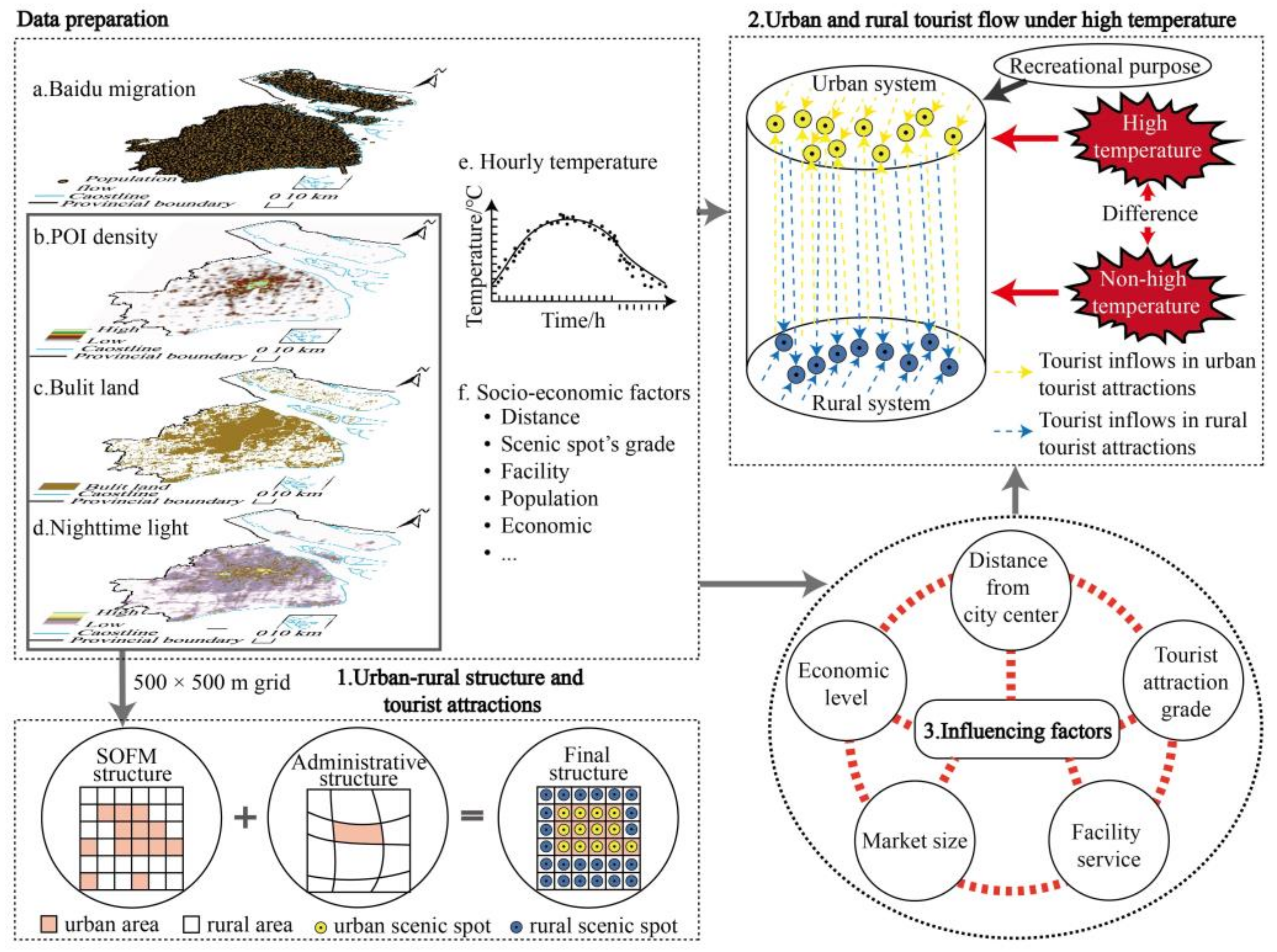
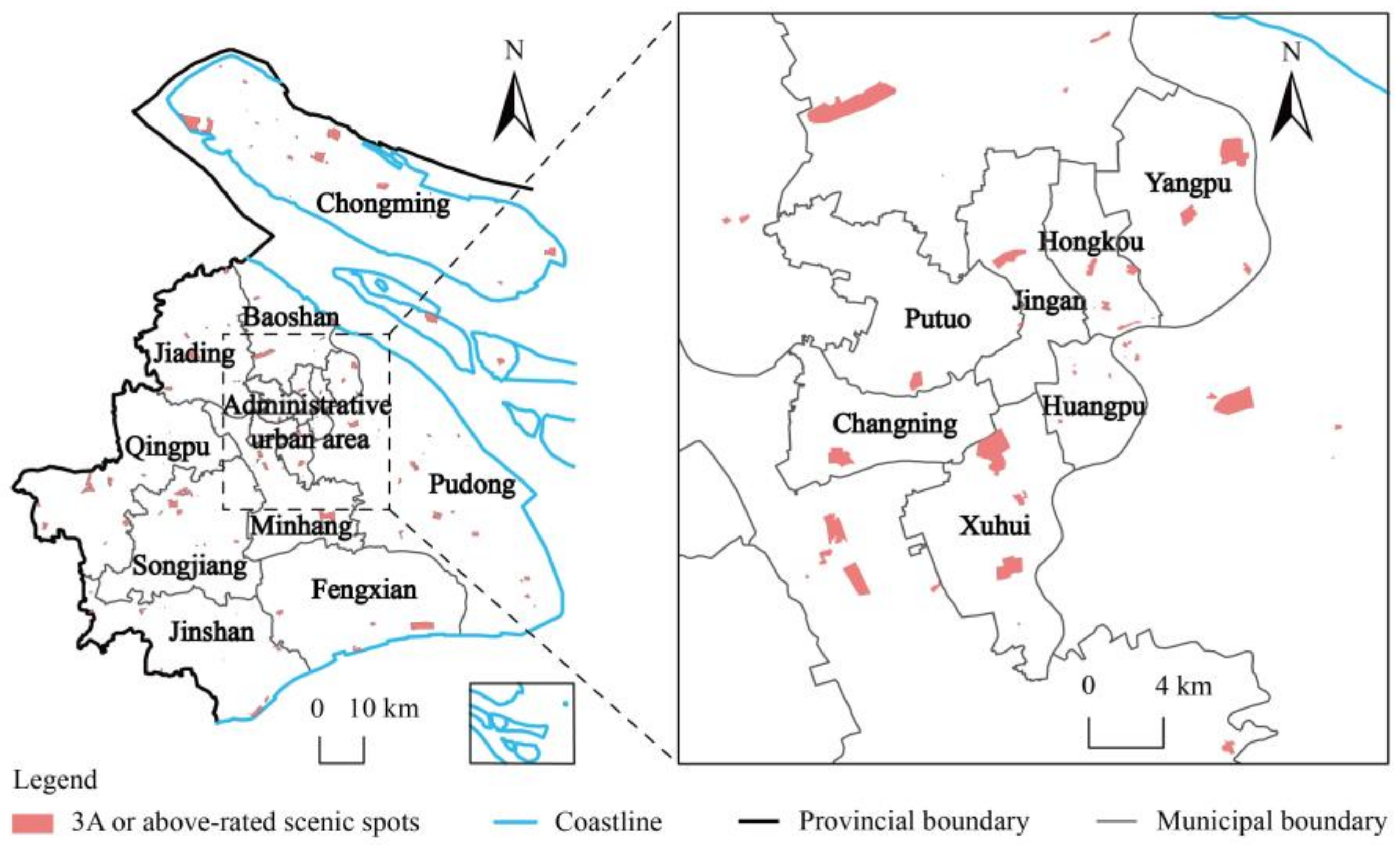
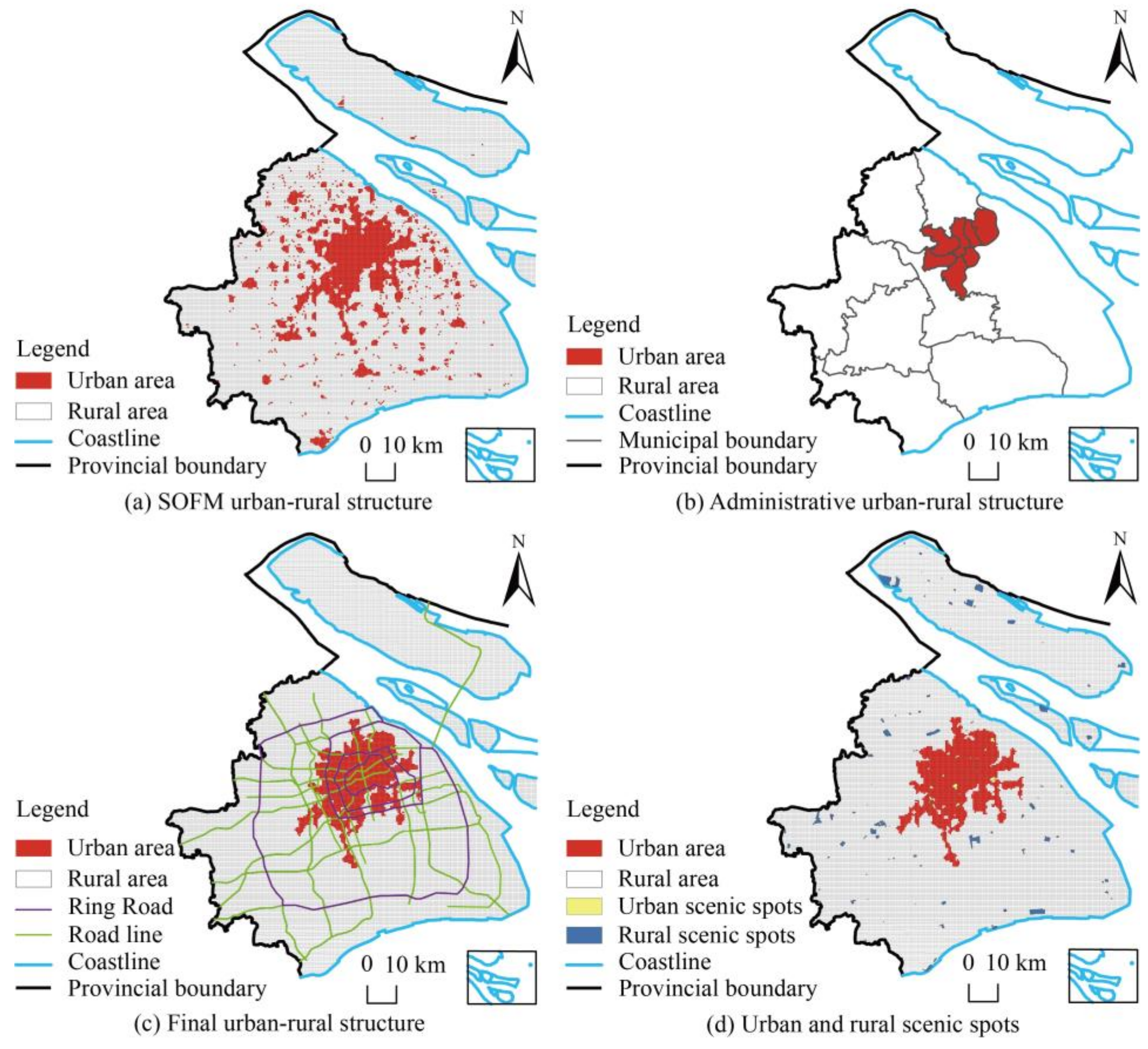


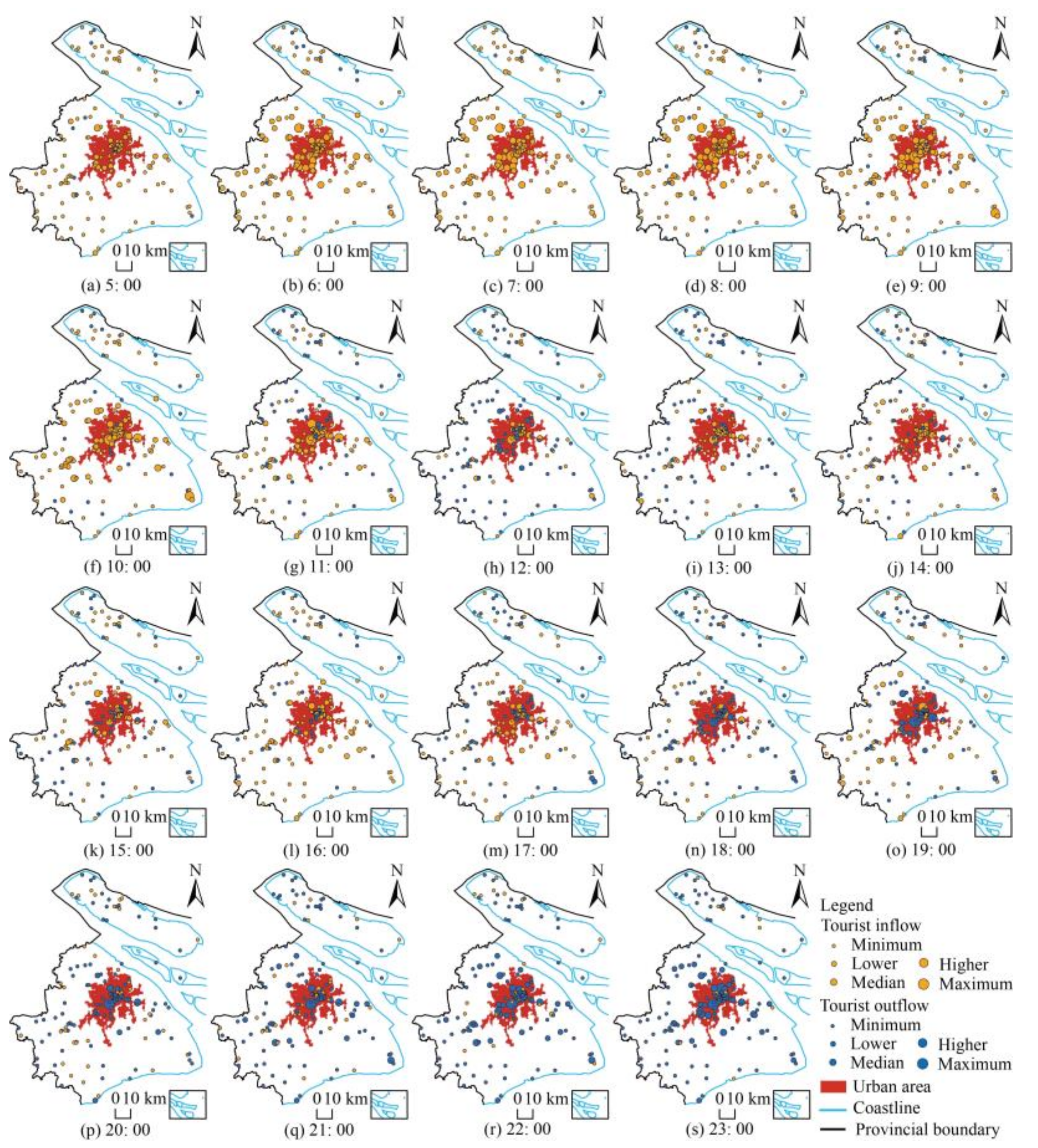
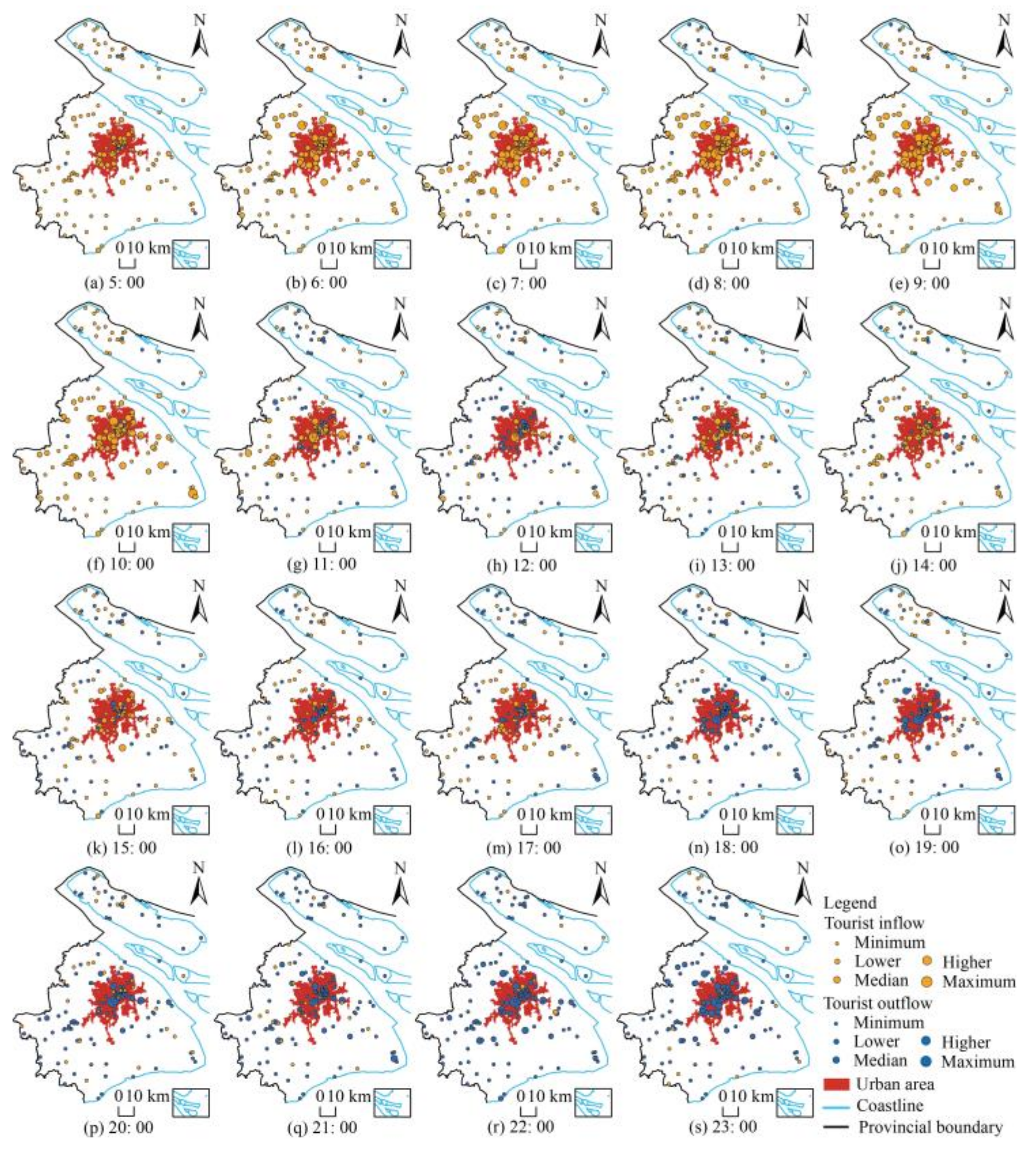
| Time (h) | Urban Tourist Flow | Rural Tourist Flow | ||||||||
|---|---|---|---|---|---|---|---|---|---|---|
| Dis | Gra | Ame | Den | Eco | Dis | Gra | Ame | Den | Eco | |
| 0 | 0.275 | 0.054 | −0.268 | 0.017 | −0.078 | 0.405 ** | −0.201 * | −0.288 ** | −0.468 ** | −0.161 |
| 1 | 0.299 * | 0.047 | −0.180 | −0.055 | −0.025 | 0.411 ** | 0.187 | −0.415 ** | −0.469 ** | −0.065 |
| 2 | 0.256 | 0.094 | −0.075 | −0.020 | 0.058 | 0.405 ** | −0.201 * | −0.395 ** | −0.467 ** | −0.113 |
| 3 | 0.313 * | −0.041 | −0.267 | −0.124 | −0.058 | 0.392 ** | −0.182 | −0.421 ** | −0.342 ** | −0.125 |
| 4 | 0.272 | 0.023 | −0.131 | −0.147 | 0.014 | 0.269 ** | −0.188 | −0.143 | −0.354 ** | −0.062 |
| 5 | 0.085 | −0.258 | −0.346 * | −0.069 | −0.374 ** | −0.360 ** | 0.178 | 0.202 * | 0.437 ** | 0.192 |
| 6 | −0.171 | −0.046 | 0.025 | 0.054 | −0.109 | −0.406 ** | 0.160 | 0.358 ** | 0.471 ** | 0.136 |
| 7 | −0.235 | 0.039 | 0.116 | 0.019 | 0.007 | −0.374 ** | 0.213 * | 0.287 ** | 0.441 ** | 0.043 |
| 8 | −0.232 | −0.004 | 0.143 | 0.005 | −0.005 | −0.362 ** | 0.257 * | 0.330 ** | 0.425 ** | 0.066 |
| 9 | −0.301 * | 0.086 | 0.239 | −0.018 | 0.163 | −0.367 ** | 0.349 ** | 0.288 ** | 0.432 ** | 0.246 * |
| 10 | −0.264 | 0.171 | 0.407 ** | −0.073 | 0.345 * | −0.250 * | 0.369 ** | 0.222 * | 0.302 ** | 0.210 * |
| 11 | −0.251 | 0.226 | 0.392 ** | −0.080 | 0.353 * | −0.076 | 0.299 ** | 0.104 | −0.047 | 0.164 |
| 12 | −0.179 | 0.187 | 0.430 ** | 0.010 | 0.358 * | 0.227 * | −0.011 | −0.065 | −0.357 ** | 0.094 |
| 13 | −0.146 | 0.035 | 0.291 * | −0.111 | 0.295 * | −0.060 | 0.052 | −0.173 | 0.090 | −0.067 |
| 14 | −0.287 | 0.286 | 0.364 * | −0.133 | 0.403 ** | −0.127 | 0.171 | −0.054 | 0.220 * | 0.138 |
| 15 | 0.016 | 0.096 | −0.039 | −0.245 | −0.194 | −0.125 | 0.054 | −0.155 | 0.264 ** | 0.005 |
| 16 | 0.009 | −0.007 | 0.195 | −0.170 | 0.233 | −0.330 ** | 0.268 ** | 0.252 * | 0.284 ** | 0.218 * |
| 17 | −0.038 | −0.241 | 0.080 | 0.060 | 0.114 | −0.116 | −0.121 | 0.111 | 0.033 | −0.105 |
| 18 | 0.237 | −0.295 * | −0.078 | −0.223 | −0.106 | −0.045 | −0.114 | 0.437 ** | −0.159 | −0.064 |
| 19 | 0.157 | −0.246 | −0.083 | 0.150 | −0.019 | 0.021 | −0.120 | 0.302 ** | −0.229 * | −0.010 |
| 20 | 0.272 | −0.135 | −0.421 ** | −0.050 | −0.361 * | 0.218 * | −0.342 ** | −0.035 | −0.186 | −0.109 |
| 21 | 0.207 | −0.092 | −0.338 * | 0.137 | −0.297 * | 0.250 * | −0.271 ** | −0.427 ** | −0.207 * | −0.251 * |
| 22 | 0.129 | −0.073 | −0.235 | 0.128 | −0.210 | 0.359 ** | −0.296 ** | −0.359 ** | −0.329 ** | −0.169 |
| 23 | 0.177 | 0.034 | −0.278 | 0.069 | −0.236 | 0.434 ** | −0.306 ** | −0.331 ** | −0.441 ** | −0.197 |
| Time (h) | Urban Tourist Flow | Rural Tourist Flow | ||||||||
|---|---|---|---|---|---|---|---|---|---|---|
| Dis | Gra | Ame | Den | Eco | Dis | Gra | Ame | Den | Eco | |
| 0 | 0.256 | 0.030 | −0.239 | 0.029 | −0.063 | 0.432 ** | −0.223 * | −0.381 ** | −0.447 ** | −0.131 |
| 1 | 0.311 * | 0.007 | −0.205 | −0.074 | −0.030 | 0.427 ** | −0.199 * | −0.427 ** | −0.481 ** | −0.155 |
| 2 | 0.258 | 0.065 | −0.108 | −0.086 | 0.078 | 0.419 ** | −0.191 | −0.420 ** | −0.442 | −0.060 |
| 3 | 0.303 * | 0.017 | −0.213 | −0.082 | −0.005 | 0.380 ** | −0.174 | −0.389 ** | −0.456 ** | −0.129 |
| 4 | 0.323 * | 0.028 | −0.161 | −0.154 | −0.04 | 0.275 ** | −0.203 * | −0.531 ** | −0.209 * | 0.005 |
| 5 | 0.038 | −0.209 | −0.262 | 0.008 | −0.353 * | −0.386 ** | 0.158 | 0.299 ** | 0.456 ** | 0.175 |
| 6 | −0.186 | −0.047 | 0.037 | 0.054 | −0.098 | −0.399 ** | 0.194 | 0.291 ** | 0.491 ** | 0.169 |
| 7 | −0.209 | 0.005 | 0.081 | 0.003 | −0.048 | −0.381 ** | 0.199 * | 0.348 ** | 0.430 ** | 0.043 |
| 8 | −0.230 | −0.023 | 0.140 | 0.029 | 0.028 | −0.380 ** | 0.267 ** | 0.359 ** | 0.446 ** | 0.086 |
| 9 | −0.255 | 0.062 | 0.192 | 0.005 | 0.111 | −0.390 ** | 0.358 ** | 0.326 ** | 0.441 ** | 0.207 * |
| 10 | −0.277 | 0.172 | 0.334 * | −0.032 | 0.285 | −0.350 ** | 0.446 ** | 0.338 ** | 0.348 ** | 0.314 ** |
| 11 | −0.252 | 0.173 | 0.394 ** | −0.016 | 0.310 * | −0.144 | 0.307 ** | 0.104 | 0.010 | 0.197 |
| 12 | −0.172 | 0.172 | 0.414 ** | −0.096 | 0.357 * | 0.147 | 0.069 | 0.064 | −0.248 * | 0.096 |
| 13 | −0.217 | 0.019 | 0.352 * | 0.056 | 0.425 ** | −0.110 | 0.146 | −0.130 | 0.140 | 0.014 |
| 14 | −0.370 * | 0.291 * | 0.393 ** | −0.021 | 0.446 ** | −0.221 * | 0.350 ** | 0.079 | 0.260 ** | 0.054 |
| 15 | −0.015 | 0.079 | 0.036 | −0.151 | −0.044 | −0.250 * | 0.037 | −0.103 | 0.356 ** | 0.114 |
| 16 | 0.187 | −0.017 | −0.151 | −0.188 | −0.086 | −0.086 | −0.202 * | 0.060 | 0.037 | −0.024 |
| 17 | 0.059 | −0.244 | 0.040 | −0.232 | −0.073 | −0.045 | −0.311 ** | 0.077 | 0.097 | −0.155 |
| 18 | 0.269 | −0.243 | −0.202 | −0.111 | −0.261 | 0.252 * | −0.376 ** | 0.029 | −0.339 ** | −0.202 * |
| 19 | 0.226 | −0.154 | −0.149 | 0.049 | −0.095 | 0.170 | −0.236 * | 0.195 | −0.362 ** | −0.070 |
| 20 | 0.246 | −0.149 | −0.331 * | −0.036 | −0.241 | 0.271 ** | −0.362 ** | −0.174 | −0.201 * | −0.128 |
| 21 | 0.146 | −0.058 | −0.291 * | 0.068 | −0.266 | 0.256 * | −0.282 ** | −0.323 ** | −0.251 * | −0.234 * |
| 22 | 0.141 | −0.045 | −0.237 | 0.222 | −0.209 | 0.394 ** | −0.263 ** | −0.433 ** | −0.381 ** | −0.170 |
| 23 | 0.232 | −0.030 | −0.272 | 0.045 | −0.190 | 0.433 ** | −0.265 ** | −0.364 ** | −0.457 ** | −0.185 |
Disclaimer/Publisher’s Note: The statements, opinions and data contained in all publications are solely those of the individual author(s) and contributor(s) and not of MDPI and/or the editor(s). MDPI and/or the editor(s) disclaim responsibility for any injury to people or property resulting from any ideas, methods, instructions or products referred to in the content. |
© 2025 by the authors. Licensee MDPI, Basel, Switzerland. This article is an open access article distributed under the terms and conditions of the Creative Commons Attribution (CC BY) license (https://creativecommons.org/licenses/by/4.0/).
Share and Cite
Wei, M.; Huang, T. Impact of High Temperatures on Tourist Flows in Urban and Rural Areas: Climate Adaptation Strategies in China. Agriculture 2025, 15, 980. https://doi.org/10.3390/agriculture15090980
Wei M, Huang T. Impact of High Temperatures on Tourist Flows in Urban and Rural Areas: Climate Adaptation Strategies in China. Agriculture. 2025; 15(9):980. https://doi.org/10.3390/agriculture15090980
Chicago/Turabian StyleWei, Man, and Tai Huang. 2025. "Impact of High Temperatures on Tourist Flows in Urban and Rural Areas: Climate Adaptation Strategies in China" Agriculture 15, no. 9: 980. https://doi.org/10.3390/agriculture15090980
APA StyleWei, M., & Huang, T. (2025). Impact of High Temperatures on Tourist Flows in Urban and Rural Areas: Climate Adaptation Strategies in China. Agriculture, 15(9), 980. https://doi.org/10.3390/agriculture15090980






